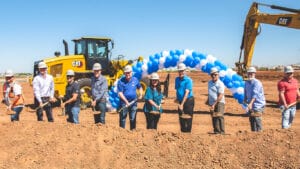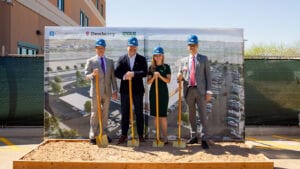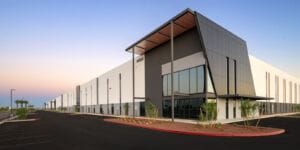Healthcare construction projects are on the rise in Arizona and across the United States. Spurring the increase is competition among hospitals, aging facilities, growing populations and demand for new and changing healthcare technology. Industry experts estimate the boom will exceed $60 billion a year by 2010.
Construction costs are also soaring and putting pressure on an already stretched healthcare system. Between 1999 and 2006, construction costs in San Francisco jumped from $190 PSF to over $600 PSF. They also rose dramatically in the Phoenix market. Kip Edwards, system vice president for design and construction of Banner Health, created the following chart to illustrate cost escalation between 2004 and 2009.
“Our biggest challenge is always cost,” says Edwards. “It used to be $1 million a bed to build a hospital, but now it’s closer to $2 million.”
Edwards says one of the biggest factors driving capital costs is Information Technology. Hospitals and medical facilities at one time budgeted hundreds of thousands of dollars to pay for IT, but now must budget millions. Additional resources are also necessary to create flexibility for future growth, such as producing excess capacity for the continued addition of information systems, sizing up computer closets and HVAC systems and adding extra electrical power for future needs. Plus, there are always costs that you might not even think about at first. Help with transportation to the hospital is generally overlooked, but can add a decent chunk of costs at the end of the year.
Healthcare Technology: Building Information Modeling (BIM)
To help manage these growing costs, many healthcare construction teams are using BIM, a technological tool designed to detect problems prior to construction and reduce downtime in the field. BIM enables users to create a virtual 3D model of an entire building, including walls, finishes, heating and air conditioning, plumbing, electrical, etc. Each trade creates its own 3D model at the start of a project. The models are then imported into a software program called Navisworks, which analyzes the drawings to detect collisions in the project.
Sharon Harper, CEO of The Plaza Companies, contends BIM is one of the most important pieces of technology used to develop healthcare facilities today.
“Healthcare facilities are extremely complex and each area has specific challenges,” she says. “The ceiling in an operating room, for example, is full of pipes and ducts because the room has special air requirements. With BIM, we can build all that into the model and then run conflict resolution to maintain control over what goes into the ceiling. BIM helps us optimize the design, and make it better and less costly.”
Information Highway
Server-based project management systems are also widely used today to help run healthcare construction projects. Orcutt|Winslow, a Phoenix-based architectural firm, creates a Web site for each of its projects through an online database they call Virtual Project. Members of the construction team can log onto the Web site anytime from anywhere, and check the progress of the project. They can also look at staff hours, schedules, updates, construction documents, the project’s budget and floor plan.
“The Web sites allow our project teams to share information quickly and effectively,” says Neil Terry, a partner at Orcutt|Winslow. “Before Web sites, we used scanners and fax machines and e-mailed PDFs. But e-mail has limitations on the size of file you can send, whereas any size file can be uploaded to a Web site.”
Computerization
Steve Steinberg, former senior director of Lauth Property Group, says great advancements in healthcare and the market sector’s construction have taken place over the last five years, due to the computer and its ability to analyze information quickly and distribute it globally. He also contends that healthcare delivery is on the cusp of a paradigm change.
“The face of healthcare delivery is changing,” Steinberg says. “Hospitals are becoming infused with research and development components so delivery of care will become more personalized and specific to a person’s profile. That means hospitals will have doctors and nurses, plus added care givers like scientists, on their team who will advise on genetic and molecular levels and create treatments that are custom-designed for each person.”
[stextbox id=”grey”]
Links for more information about healthcare technology:
[/stextbox]
Per Diem Offices
UTAZ Development in Gilbert is building medical per diem offices in several locations around the Valley to help attract doctors and specialist to local hospitals.
The purpose of the per diem offices is twofold: (1) to provide physicians and healthcare practitioners an opportunity to establish a new practice or expand an existing practice in a new community; (2) and to provide temporary medical offices for practitioners waiting for new office space to be completed.
The daily, short-term lease rates associated with these per diem offices allow the practitioner flexibility in the number of hours and days they will occupy the space, thus minimizing the cost and risks associated with typical lease terms.
“This concept is not unlike the executive office suites created for general office use,” says Terri Tobey, senior vice president of sales and marketing for UTAZ. “The difference is that the UTAZ per diem offices are designed specifically to accommodate the medical user.”
The 1,500 SF per diem offices include architectural and design features that create a welcoming and healing environment. Each office also has a procedure room and basic exam rooms that are fully furnished and stocked with basic medical supplies, as well as individual locked storage for each lessee to secure their own specific supplies.
Physician and healthcare practitioners can lease the space on a per-day or per half-day basis, one to six days per week. Lease rates are $150 per half day, $300 for a full day. Terms can be as short as six months or as long as two years.
UTAZ provides all basic medical supplies such as exam table paper, cotton swabs, tongue depressors and other disposals. They also supply basic exam equipment such as otoscopes, blood pressure devices and thermometers, as well as office equipment such as phone, fax and copy machine.
“We’re trying to help the Valley attract doctors and specialists,” Tobey says. “There’s still a great need for medical professionals in Arizona. The challenge is finding the perfect location with the attributes needed for success.”
[stextbox id=”grey”]www.utaz.com[/stextbox]



